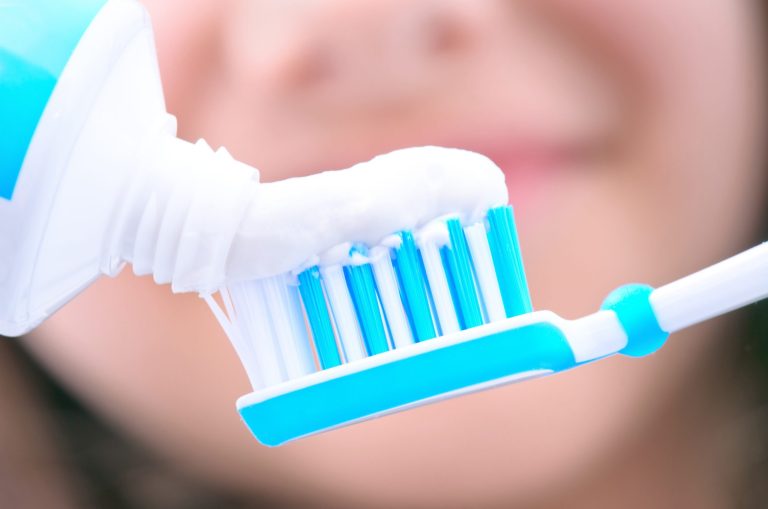When the FDA banned triclosan from soap and body wash in September 2016, citing concerns about the safety of long-term use,1 many people were left wondering why the ban did not extend to toothpaste. If triclosan is not safe for handwashing, is it really safe for people to put it in their mouths two or three times a day? According to the FDA, triclosan should be allowed to remain in toothpaste because it is particularly effective for preventing gingivitis and reducing plaque,2 but many consumers are looking for alternatives that offer oral health benefits without posing potential health risks.
At the same time, there have been growing consumer concerns about toothpaste containing fluoride over the last few years. While fluoride helps prevent and reverse tooth decay,3 ingestion of this toxic compound can lead to dental fluorosis (which causes permanent tooth discoloration), gastrointestinal problems, perioral dermatitis and glucose metabolism impairment.4 As people increasingly question the safety of the ingredients in traditional toothpaste, consumer packaged goods (CPG) companies are coming under greater pressure to offer options that contain alternative ingredients. Modern software can help researchers at these firms conduct alternative toothpaste investigatory projects in order to develop safer formulations that will appeal to customers who are skeptical about traditional toothpaste, as well as comply with all the necessary FDA regulations.
The Benefits of Formulation Development Software
For CPG firms on a tight budget and a tighter schedule, it can be difficult to take into account the concerns of researchers, regulators and consumers all at once. Especially for those who want to gain a foothold in the growing market for triclosan- and fluoride-free oral health solutions, streamlining the process and getting a product into the market is of the utmost importance. Modern formulation development software can help with this in several ways, including:
● Sourcing Alternative Toothpaste Ingredients As consumers search the market for a new toothpaste that doesn’t contain triclosan or fluoride, they still want it to offer the same oral health benefits—reducing plaque and gingivitis. Recent studies have demonstrated that a wide variety of ingredients have these and other benefits. For instance, zinc citrate effectively eliminates the bacteria that cause gingivitis,5 while a papaya plant extract contains an enzyme that removes stains and whitens teeth without eating away at enamel.6 As researchers add and remove ingredients like these, they have to be cognizant of the effects of the changes on the final product. This means maintaining the expected texture of toothpaste, finding the right color, and guaranteeing a pleasing flavor.
● Enabling Time-saving In Silico Experiments Finding the right combination of ingredients can be time-consuming for researchers, but modern software can streamline the process. Not only does it make it easier for scientists to identify and source high-quality ingredients for formulations testing, but it also enables in silico experiments that offer insight into the properties of a formulation before scientists test the recipe at the bench. That way, scientists can quickly try out new ingredient combinations and make incremental adjustments in concentrations until they find an ideal formulation. Only then is the toothpaste subjected to traditional wet lab tests. This cuts down on material costs and speeds the overall research process, since scientists waste less time mixing ingredients at the bench.
● Accessing Large Amounts of Data Another key benefit of modern software is that it makes it easy to access old data from previous experiments. Results from tests on traditional toothpaste formulations can help researchers figure out which ingredients were the most important for imparting the ideal texture, color and flavor to the original formulation. Moreover, easy access to existing data allows researchers to build on their findings as they develop more varieties of toothpaste that do not contain triclosan or fluoride. They can apply their results from tests on a fluoride- and triclosan-free adult toothpaste to the development of a kid’s version or one designed for people who have sensitive teeth. In this way, software enables scientists to make necessary tweaks without having to conduct a full set of tests on the new formulations.
● Cutting Down on Compliance Risks Once scientists have developed a new toothpaste recipe, they must evaluate the final formulation in order to ensure that it complies with existing regulatory standards. Even though the FDA currently allows triclosan and fluoride to be included in toothpastes, it still has a wide range of safety and labeling requirements. In addition, a new toothpaste must undergo comprehensive tests by the American Dental Association in order to receive the organization’s seal of approval,7 which many consumers consider to be essential when they buy a new toothpaste. Modern software offers chemical management capabilities that make it easier for researchers to stay in compliance with FDA and ADA regulations, without having to keep track of every detail, as they develop and test new ingredient combinations.
By paying attention to consumers who are concerned about the health risks of current toothpaste ingredients, CPG companies can gain a foothold in the growing market for triclosan- and fluoride-free oral health solutions. Modern software makes it easy to explore and develop new toothpaste formulations and get them to market quickly and safely, before the buzz about the FDA ban on triclosan dies down.
BIOVIA’s Perfect Lab Industry Solution Experience can streamline the research and development process for new toothpaste formulations.
1 “FDA issues final rule on safety and effectiveness of antibacterial soaps,” September 2, 2016, http://www.fda.gov/NewsEvents/Newsroom/PressAnnouncements/ucm517478.html 2 “Why a Chemical Banned From Soap Is Still in Your Toothpaste,” September 7, 2016, http://www.nytimes.com/2016/09/07/well/live/why-your-toothpaste-has-triclosan.html?_r=0 3 “Dental Health and Fluoride Treatment,” 2016, http://www.webmd.com/oral-health/guide/fluoride-treatment#1 4 “Dental Products,” 2016, http://fluoridealert.org/issues/dental-products/toothpastes/ 5 “Six Natural Ingredients in Fluoride Free Toothpaste,” 2016, http://www.colgate.com/en/us/oc/oral-health/basics/selecting-dental-products/article/six-natural-ingredients-in-fluoride-free-toothpaste-1014 6 “Organic Toothpastes That Help Whiten Teeth,” 2016, http://homeguides.sfgate.com/organic-toothpastes-whiten-teeth-78513.html 7 “Learn More About Toothpastes,” 2016, http://www.ada.org/en/science-research/ada-seal-of-acceptance/product-category-information/toothpaste
